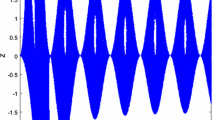Abstract
The numerical integration of the differential equations describing dynamical systems has been shown in previous papers of this series to be most effectively accomplished by an explicit Taylor series method.
In this paper we show that one explicit Taylor series method, developed earlier in this series and which appears to possess a high degree of versatility, yields considerable gains in efficiency over classical single-step and multi-step methods. (In this context efficiency is a measure of the time taken to carry out a calculation of a specific accuracy).
For a given accuracy criterion governing the local truncation error (LTE) it is found that the Taylor series method is generallytwice as fast as the classical multi-step method and up totwenty times faster than the classical single-step method.
Similar content being viewed by others
References
Barton, D., Willers, I. M., and Zahar, R.: 1970, in J. R. Rice (ed.),Mathematical Software, Academic Press, Lafayette, 369.
Bettis, D.: 1973,Celes. Mech.,8, 229
Deprit, A. and Zahar, R. V. M.: 1966,ZAMP 17, 425.
Dormand, J. and Prince, P.: 1978,Celes. Mech. 18, 223.
Emslie, A. G. and Walker, I. W.: 1979,Celes. Mech. 19, 147.
Henrici, P.: 1963,Discrete Variable Methods in Ordinary Differential Equations, New York, P. 68.
Jackson, K. et al.: 1978,SIAM Journal of NA No. 3, 618.
Krogh, F. T.: 1971,Algorithms for Changing the Stepsize Used by a Multi-step Method Jet Propulsion Laboratory Section 314, Tech. Memo. 275.
Mayers, D. F.: 1962, in L. Fox (ed.),Methods of Runge-Kutta Type, Numerical Solution of Ordinary and Partial Differential Equations, Pergamon, pp. 16–27.
Merson, C. H.: 1973,Numerical Integration of the Differential Equations of Celestial Mechanics, Royal Aircraft Establishment Report.
Roy, A. E., Moran, P. E., and Black, W.: 1972,Celes. Mech. 6, 468.
Shampine and Gordon: 1975,Computer Solution of ODE's, Freeman.
Author information
Authors and Affiliations
Rights and permissions
About this article
Cite this article
Schwarz, H.E., Walker, I.W. Studies in the application of recurrence relations to special perturbation methods. Celestial Mechanics 27, 191–202 (1982). https://doi.org/10.1007/BF01271693
Received:
Accepted:
Issue Date:
DOI: https://doi.org/10.1007/BF01271693




